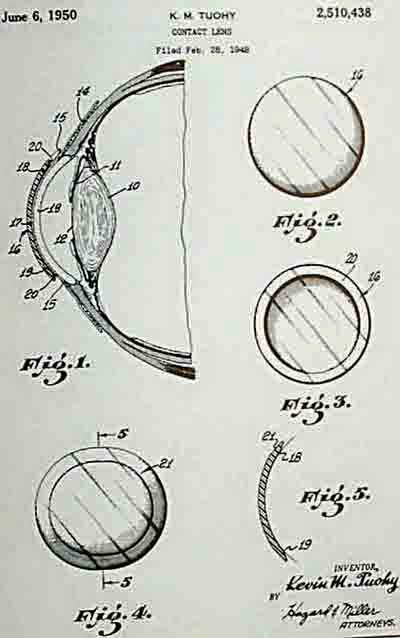Hard / Rigid Contact Lenses
Hard contact lenses are the original form of contact lens. It was first introduced in 1948 by Kevin Tuohy (1919-1968). He began his experiments in the mid - 1940's at Obrig Laboratories in New York City and finished them at Solex Laboratories in Southern California.
Tuohy applied for patent in 1947 and was granted in June 1950. Despite the previous unsuccessful attempts by Tuohy's predecessors, much of the acceptance of Tuohy's contacts are due to Los Angeles actors who eagerly adopted whatever would give their careers a boost and the support of several respected physicians.
The first contact lenses created by Tuohy was made from polymethylmethacrylate (PMMA) otherwise known as acrylic glass.
IUPAC Name: Poly (methyl - 2 - methylpropenoate)
These types of lenses are difficult to adapt to as they are impermeable and lubrication is majorly dependent on the eye's ability to create tears. For people who currently wear contacts and have problems with dry eyes, hard contacts results the same only worse. On the positive side, the diameter of hard contacts are much smaller than the current soft contacts (see image below), which makes it manageable and the process of creating the PMMA is called annealing where in the material is exposed to successive heating and cooling sequence leaving the final product free of toxic chemicals.
Size Comparison Between Soft and Hard Contact Lenses
Below is a list of 10 reasons why rigid contact lenses are obsolete according to OpticianOnline.Net on its Contact Lens Monthly published at July 01, 2011.
- "Initial Discomfort with Rigid Lenses"
- They always have been, and will be uncomfortable. This is fundamentally due to the impermeable nature of the material
- Uncontrollable Complications to Eye and Lid Pathology (See images below)
- Blepharoptosis: abnormal dropping of the upper eyelids
- 3 & 9 o’clock Staining / Peripheral Corneal Desiccation: corneal staining at regions at the edge of the rigid contact lenses.
- Surfacing of Better Alternatives:
- Development of soft contact lens with much fewer disadvantages.
- Superior Soft Lens Fitting Logistics:
- Ease and ready availability of materials at an "almost complete range of parameters and powers"
- Rigid contact lens takes far longer time time to fit and must be ordered at a custom laboratory.
- Lack of Training Facilities for Practitioners
- Optometry schools usually mimic real world scenarios where patients are expected to be fitted soft contact lenses. Hard contact lens fitting is considered as a rarity, and thus students usually are taught to fit "by theory"
- Role as a "Problem Solver" is No Longer Necessary:
- Hard contact lenses were often used as a secondary options in case soft contacts is not a good fit for a patient up until mid-1980.
- Due to continuous advancement in technology and manufacturing, much of the previous incompatibility have mostly been resolved or the effects greatly reduced making hard contacts, with all its time consuming process, more trouble than its worth.
- Improved Soft Toric and Bifocal / Varifocal Lenses
- Limited Uptake of Orthokeratology
- Lack of Investment on Rigid Contact Lenses
- Makes sense, why invest on something that clearly is not working, waste money on development when there already exists an alternative whose pros greatly outweighs whatever development the wasted money could ever come up with.
- Emergence of Aberration-Control Soft Lens
- Like all the rest of the reasons, better alternative outweighs the predecessor.
Examples of Complications of Wearing Rigid Contact Lens: Left Blepharoptosis, Right Peripheral Corneal Desiccation



.jpg)



No comments:
Post a Comment